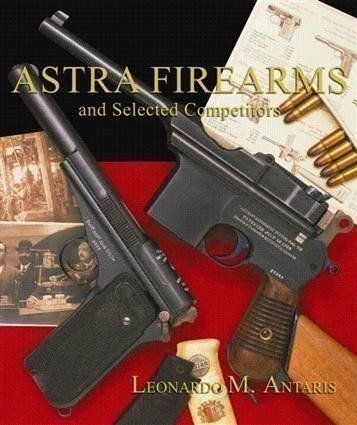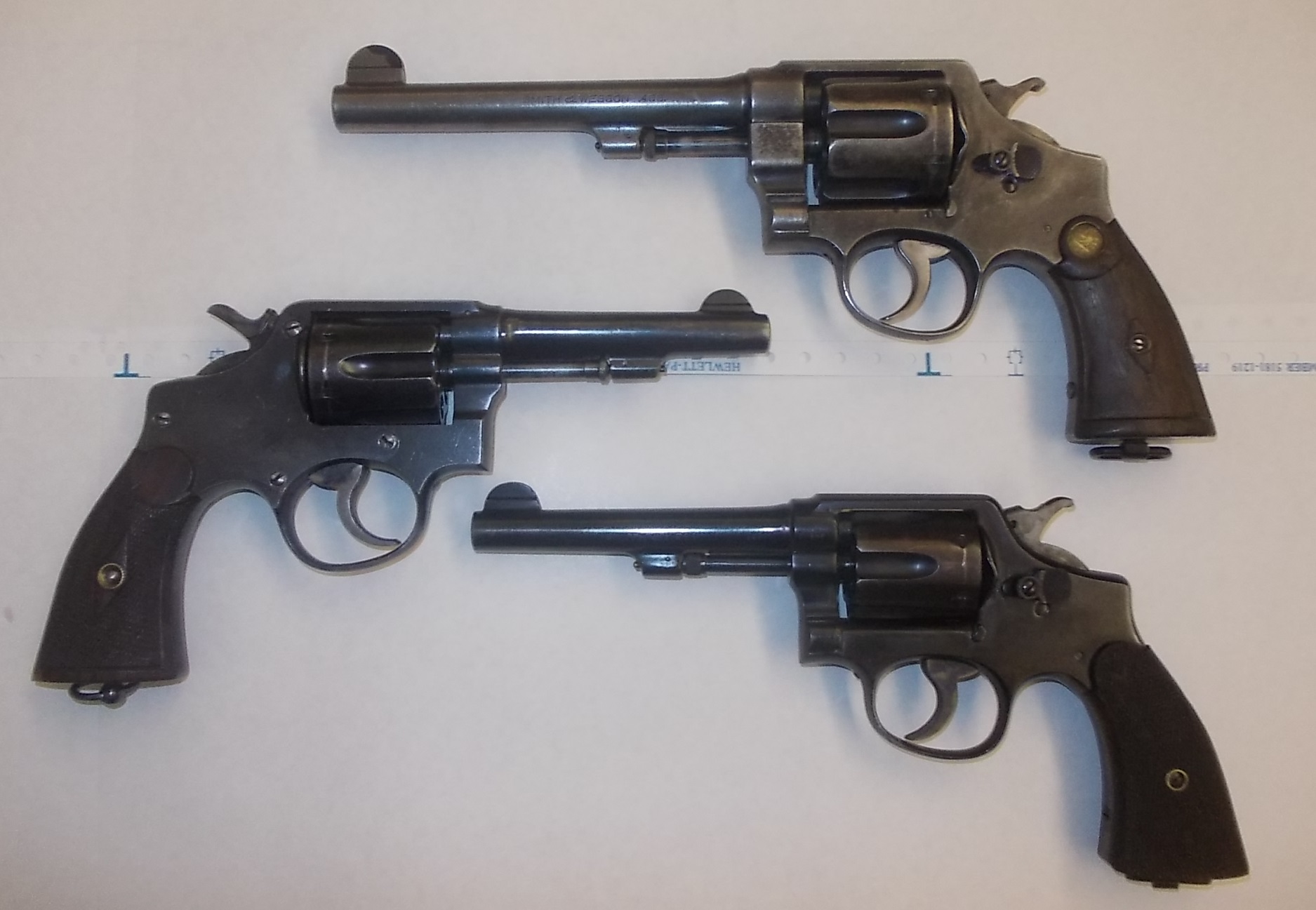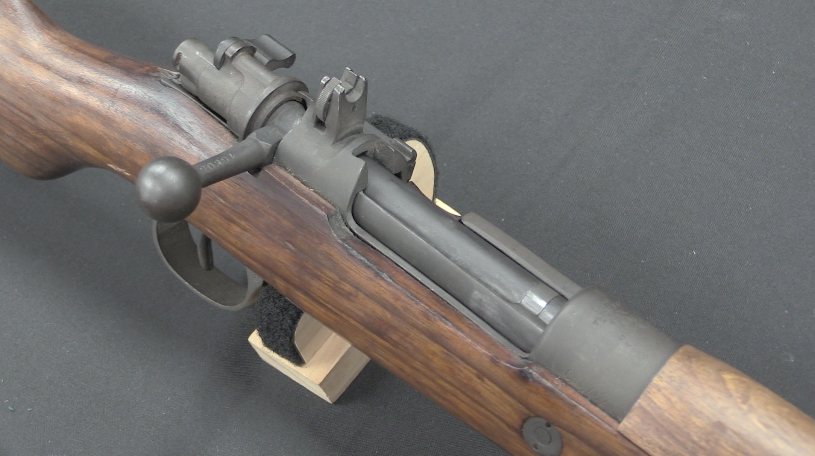The “Plus Ultra” was a variation on the Ruby automatic pistol made by Gabilondo y Urresti (the original holders of the Ruby trademark) just shortly before they changed their name to Llama. The Plus Ultra was a scaled-up Ruby using double stack, 22-round magazines (still chambered for .32ACP). It offered much greater capacity than the standard pistols, and a few were actually made as select-fire guns. They never sold particularly well, though, and are rather uncommon today.
Related Articles

Book review
Book Review: “Star Firearms” and “Astra Firearms” by Leonardo Antaris
Leonardo Antaris has written massive and excellent volumes on two of the major companies in the Spanish firearms industry, Star and Astra. Both of these companies made a wide range of military and commercial handguns, […]

Revolver
Eibar “Spanish Model 92” Revolver
Today’s post is a guest article written by Mike Burns, taking a look at one of the S&W revolver copies made in Eibar for the French military. He compares it to a WWI .455-caliber S&W […]

Bolt Action Rifles
RIA – Spanish FR-8: the “Cetmeton”
The FR-8 is a Spanish rifle manufactured in the 1950s as part of Spain’s adoption of the CETME semiautomatic rifles. Spain was not only moving to their first semiauto rifle, but also changing from 8mm […]

Maybe the rather large pistol was not a good idea for a gun in 32 ACP. People generally expect big guns to chamber powerful stuff, not pocket gun ammunition… Or am I wrong?
A very common caliber for pistols at the time, 7.65mm. Large pistols or service-type handguns in Spain were typically in 9mm largo at the time. Very many of the Ruby pistol manufactories in Euskadi/the Basque country had already made many Ruby pistols for France and Italy in WWI, so…
Does anybody manufactured Ruby-like automatic pistol with double stack magazine, but standard size grip (not extended)?
7.65 mm is the army caliber in many European countries. It’s a standard that includes also assault weapons such as the AK 49, not just pistols.
Any idea of the price range for a Astra Ruby pistol?
An oft reproduced photo of a Kamikaze pilot adjusting his head scarf shows what appears to be one of these tucked into a belly strap. Quality of reproduction doesn’t show grip markings clear enough to tell. In some uncroped photos the long grip is very noticeable. Any sold to Japan ? Or China ?
Hi John,
The ‘hi-cap’ ruby style Spanish pistols were quite popular in the Asian market. I remember reading somewhere that that the pistol the pilot had tucked away was a Zulaica ‘Royal’ rather than an Astra ‘Plus Ultra’. Japanese officer bought their own pistols until 1943 I believe, Spanish pistols, Colt 1903s, Mauser 1914s, and FN 1910s seem to have been popular.
Seems those models become protégé for Polish PM63,same way barrel get removed….
Very simple way for disassembly rather than punching retaining pins out of barrel…
Be very careful with any Llama pistols, and perhaps Ruby. They have very soft steel parts, or improperly hardened parts. I have seen safeties that were so soft and squishy that the pistols would fire with the safety in the “on” position.
Is that a double feed magazine?
And what was the reason for the top ejection port? Did any other pistols try that?
Much of old European service pistols like Mauser C96, Luger, Glisenti1913, Beretta 1915, 1934 and some new Russian samples like GSh18 and Gragh have top mounted extractors and “Push Feed” loading enabling positive ejection even if the magazine is away.
The wonder .32. Yea twenty two rounds is a lot for a pocket pistol. I wonder how many rounds you could stuff in it if it were chambered for .25? Reminds me of a .22 mag Grendal.
I don’t think you should see this as a pocket pistol, it is more of a service weapon to be worn in a belt holster. Spain in the 1920s was a very unstable place, and as well as the various police forces, many landowners and industrialists had their owned armed security guards, and a pistol like this would have been a useful and not too expensive addition to their armouries.
I think he was being sarcastic…
I think he was being sarcastic about the .32 round, but at the time it was seen as quite viable, and no-one I know would like to be shot with one.
Now all you need is a horse-shoe shaped extended magazine like that from a few weeks ago–figure what? 50 rounds capacity?–and you are ready to rock.
Forgot to add that the barrel on the Astra modelo 1921 (400) can be removed the same way, by rotating the barrel 90 degrees until the barrel lugs are outside the recesses in the frame, and then pulled out.
This with auto fire and a holster-stock could have been decent PDW. Scorpion before it became cool.
I noticed that the slide (behind the rest of the slide legend) has an intertwined “GC” that is also repeated on the grips. Looks a LOT like the Guardia Civil of Spain. Possible this gun was built for a contract with them?
My theory on the naming of the Gabilondo Plus Ultra pistol is that it is essentially a commemorative piece memorializing the 1926 long distance flight of an airplane named “Plus Ultra”. Originally, “Plus Ultra” was the national motto of Spain and is derived from the warning engraved on the legendary Pillars of Hercules, which said Ne Plus Ultra or “nothing further beyond”. In the 1500s, the Spanish king Charles V adopted the motto “Plus Ultra” which means “and more beyond” to encourage exploration and colonization of the vast “new world” in pursuit of an expanded Spanish Empire. As I understand it, today, many things in Spain are named “Plus Ultra”. In 1926, Francisco Franco’s brother, Ramon and 3 other Spanish aviators made a 6,400 mile and 59 hour record breaking flight from Spain to Argentina in a Dornier flying boat. This Dornier “Wal” flying boat was named “Plus Ultra”. 1926 or shortly thereafter is the time when the “Plus Ultra” pistol first began to appear and the Plus Ultra pistol is often found with propellers and wings engraved in the slide and sometimes the grips. So I believe that there is a connection between the Plus Ultra pistol and the record breaking flight of 1926 and that the Plus Ultra pistol commemorates that event.
http://vintagesemiautorifle.proboards.com/board/11/plus-ultra-pistol
Excellent theory on the name – I checked your links to other pictures of the Ultra Plus, and saw the intertwined “GC” under crown on the pistol frame. That means these were DEFINITELY at one time issued to the Guardia Civil in Spain.
An interesting choice…
Las siglas GC no refiere a Gabilondo y Compañía? yo tengo una pistola de esas que encontré enterrada y aún funciona
I wonder why France was not interested in this pistol.
France was satisfied with the Ruby pistol (and later MAS 35 A and S). The small caliber with low energy (.32 ACP then 7,65 Longue) was very well-liked because it had low recoil, allowing for rapid succession of shots. This high number of rounds shot in a short time gave the overall impact on the target an energy comparable to a 12 caliber shot.
Thinking that way, a 22 rounds, already know by the soldiers, cheap and swift to manufacture, reliable pistol would have been the apex off the French doctrine of that time.
An elongated magazine with 30 or 40 rounds, a foldable stock and possibly a full-auto capability would have been the perfect trench-warfare weapon. If this gun had existed in 1915, I am sure it would have been adopted by French army for trench-cleaners.
Many Ruby pistols were poorly enough made that they were often fully automatic by accident. Thus, many French soldiers didn’t realize that the Ruby WAS NOT supposed to empty its magazine with one pull of the trigger.
The big question for me is, single-feed or double-feed? I can’t quite tell from the video. The interesting historical fact is this gun predated the FN Browning GP35 by a dozen years — I have read that John Browning originally opposed the double-stack single-feed magazine, believing it couldn’t be made reliable, while FN engineer Saive campaigned for it, and achieved it after Browning’s death (the simplified unlocking cam and the foolproof trigger-sear linkage in the slide were JMB’s ideas). Except for the double-stack double-feed Mauser C96, I can’t think of another double-stack pistol of this era except, now, this one. Perhaps it was seen in Belgium, and worked well enough that Saive could convince the FN directors tha fat magazine was viable for 13 rounds of 9 x 19?
It appears to be double-feed, although I didn’t actually load up the magazine. There were plenty of other such magazines around by that time, most notably the C96.
I can confirm that the Plus Ultra magazine is a double feed.
I remember seeing one of these at Deep River Armory in Houston back in the seventies. It’s the only one I have ever seen. That was back when pistols like these were coming out of the closets. Great experiences at the Houston Gun Show back then. You could actually find rare guns that were being marketed for prices just about anyone could afford if they could recognize the opportunity.
I have a Ruby. The side marking is very worn. “??EL” CAL 7.65. Serial number 9916. FC with a circle around it. Barrel stamped 916.
Any idea who, where and when it was made?
Thanks